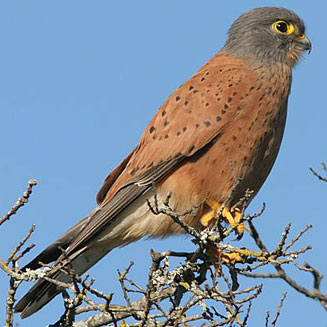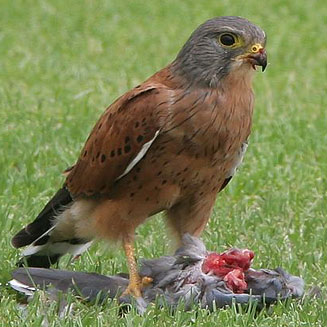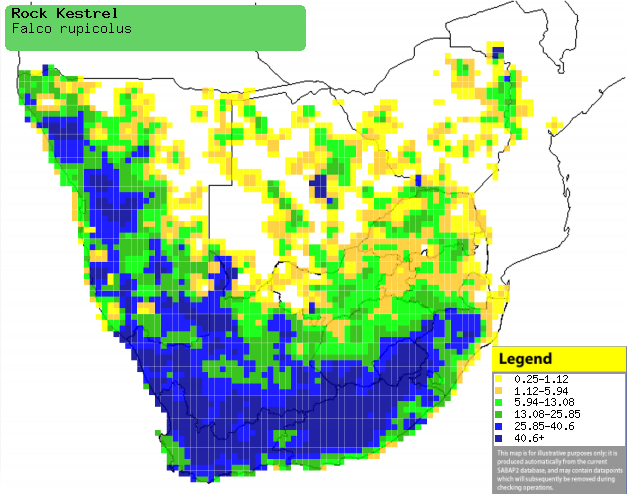|
Falco rupicolus (Rock kestrel)
[= Falco tinnunculus]
Kransvalk [Afrikaans]; Intambanane, Uthebe-thebana [Xhosa];
uMathebeni, uTebetebana [Zulu]; Kakodi (generic term for sparrowhawks, goshawks,
kestrels and falcons) [Kwangali]; Seotsanyana (applied also to other kestrel
species and to Amur falcon) [South Sotho]; Rukodzi (generic name for a small
raptor such as falcon or sparrowhawk) [Shona]; Kavakavana, Xikavakava (terms
also applied to Amur falcon) [Tsonga]; Phakalane (generic term for some of the
smaller raptors) [Tswana]; Torenvalk [Dutch]; Faucon crécerelle [French];
Turmfalke [German]; Peneireiro-vulgar [Portuguese]
Life
> Eukaryotes >
Opisthokonta
> Metazoa (animals) >
Bilateria >
Deuterostomia > Chordata >
Craniata > Vertebrata (vertebrates) > Gnathostomata (jawed
vertebrates) > Teleostomi (teleost fish) > Osteichthyes (bony fish) > Class:
Sarcopterygii (lobe-finned
fish) > Stegocephalia (terrestrial
vertebrates) > Tetrapoda
(four-legged vertebrates) > Reptiliomorpha > Amniota >
Reptilia (reptiles) >
Romeriida > Diapsida > Archosauromorpha > Archosauria >
Dinosauria
(dinosaurs) > Saurischia > Theropoda (bipedal predatory dinosaurs) >
Coelurosauria > Maniraptora > Aves
(birds) > Order: Falconiformes >
Family: Falconidae
 |
 |
|
Rock kestrel, West Coast National Park, South
Africa. [photo Trevor Hardaker ©] |
Rock kestrel feeding on a bird it caught,
Parklands, South Africa. [photo Trevor Hardaker ©] |
Distribution and habitat
Occurs from Angola, southern DRC and Tanzania south to
southern Africa, where it is common in Namibia, South Africa, Botswana,
Swaziland, Lesotho and central Mozambique. It occupies a wide variety of
habitats, generally favouring open semi-arid and arid environments, such as
grassland, Karoo and desert as well as urban centres; in the breeding season it
usually stays in areas around cliffs, which it uses for breeding and roosting.
|
 |
|
Distribution of Rock kestrel in southern Africa,
based on statistical smoothing of the records from first SA Bird Atlas
Project (©
Animal Demography unit, University of
Cape Town; smoothing by Birgit Erni and Francesca Little). Colours range
from dark blue (most common) through to yellow (least common).
See here for the latest distribution
from the SABAP2. |
Predators and parasites
It has been recorded as prey of
Bubo
capensis (Cape eagle-owl).
Movements and migrations
In the breeding season it generally stays in
the south and west, but once finished it heads north-east to
Botswana, Zimbabwe and north-eastern South Africa, probably due to
an increase in rainfall and prey abundance.
Food
It mainly eats small birds, lizards, mammals and
arthropods, either hunting from a high perch or by hovering so that it can spot
prey. Once it has done so it glides to the ground to catch the animal. It
also hawks prey aerially, which is much more exhausting for it but generally
gives greater rewards. The following food items have been recorded
in its diet:
- Animals
- birds up to the size of Columba
livia (Rock dove)
- small mammals
- reptiles
- arthropods
Breeding
- Monogamous, territorial and usually a solitary nester, although a small
quarry in the Western Cape is sometimes used by about 12 breeding pairs
spaced approximately 30 metres apart.
- The nest is typically a simple scrape in a hole or crack, alternatively
nesting on a ledge of
a cliff, quarry, road cutting or building. It may also use the nest of
another bird, such a crow or raven, placed on a cliff, tree or man-made
structure such as a utility pole.
- Egg-laying season is from September-January, peaking from a
August-October in the south-west and September-November in the south-east.
- It lays 1-6 eggs, which are mainly incubated by the female for about
26-32 days.
- The chicks are brooded and protected by the female while the male
provides food for the whole family. The young leave the nest at about 30-36
days old, becoming fully independent up to about 42 days later.
Threats
Not threatened.
References
-
Hockey PAR, Dean WRJ and Ryan PG 2005. Roberts
- Birds of southern Africa, VIIth ed. The Trustees of the John Voelcker
Bird Book Fund, Cape Town.
|
